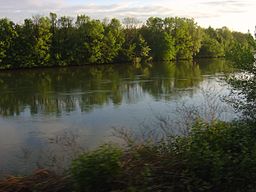River Drava
| Drava or Drave | |
| Drau, Dráva | |
| River | |
|
Drava near Ormož, Slovenia
|
|
| Countries | Italy, Austria, Slovenia, Croatia, Hungary |
|---|---|
| Cities | Lienz, Spittal an der Drau, Villach, Ferlach, Dravograd, Vuzenica, Muta, Ruše, Maribor, Ptuj, Ormož, Varaždin, Belišće, Osijek, Barcs |
| Source | North of the Neunerkogel over the Toblacher Feld |
| - location | Toblach, South Tyrol, Italy |
| - elevation | 1,450 m (4,757 ft) |
| - coordinates | 46°43′9″N 12°15′16″E / 46.71917°N 12.25444°E |
| Mouth | Danube near Osijek |
| - coordinates | 45°32′38″N 18°55′31″E / 45.54389°N 18.92528°ECoordinates: 45°32′38″N 18°55′31″E / 45.54389°N 18.92528°E |
| Length | 710 km (441 mi) |
| Basin | 40,154 km2 (15,504 sq mi) |
| Discharge | |
| - average | 670 m3/s (23,661 cu ft/s) |
|
Map of Drava River
|
|
The Drava or Drave (German: Drau [ˈdʁaʊ]; Slovene: Drava [ˈdɾàːʋa]; Croatian: Drava [drǎːʋa]; Hungarian: Dráva [ˈdraːvɒ]) is a river in southern Central Europe. With a length of 710 kilometres (440 mi), 724 kilometres (450 mi) including the Sextner Bach source, it is the fifth or sixth longest tributary of the Danube, after the Tisza, Sava, Prut, Mureș and perhaps Siret. Its source is near the market town of Innichen (San Candido), in the Puster Valley of South Tyrol, Italy. The river flows eastwards through East Tirol and Carinthia in Austria into the Styria region of Slovenia. It then turns southeast, passing through Croatia and, after merging with its main tributary Mur, forms most of the border between Croatia and Hungary, before it joins the Danube near Osijek.
...
Wikipedia


